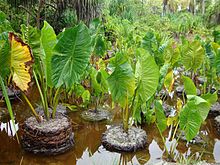Babai (Swamp Taro)
| Cyrtosperma merkusii | |
|---|---|
 |
|
| Babai cultivation in Butaritari, Kiribati. | |
| Scientific classification | |
| Kingdom: | Plantae |
| (unranked): | Angiosperms |
| (unranked): | Monocots |
| Order: | Alismatales |
| Family: | Araceae |
| Subfamily: | Lasioideae |
| Genus: | Cyrtosperma |
| Species: | C. merkusii |
| Binomial name | |
|
Cyrtosperma merkusii (Hassk.) Schott |
|
| Synonyms | |
|
|
Cyrtosperma merkusii or giant swamp taro, is a crop grown throughout Oceania and into South and Southeast Asia. It is a riverine and "swamp crop" similar to taro, but "with bigger leaves and larger, coarser roots." There are no demonstrably wild populations today, but it is believed to be native to Indonesia. It is known as puraka in Cook Islands, "Lak" in Yap (FSM), Babai in Kiribati, pula’a in Samoa, via kan in Fiji, Pulaka in Tokelau and Tuvalu, simiden in Chuuk, swam taro in Papua New Guinea, navia in Vanuatu and palawan in the Philippines.
The same species is also known by the names Cyrtosperma lasioides, Cyrtosperma chamissonis and Cyrtosperma edule.
In the harsh atoll environments of the Central Pacific, especially Tuvalu and Kiribati, swamp taro is an important source of carbohydrates in a diet dominated by fish and coconut. Its cultivation is difficult and time-consuming, and the plant has deep cultural as well as practical significance. The roots need to be cooked for hours to reduce toxicity in the corms, but are rich in nutrients, especially calcium. The cultivation of Pulaka in Tuvalu, and babai in Kiribati, is an important cultural and culinary tradition, now under threat from rising sea level and displacement from the growing use of imported food products.
...
Wikipedia
